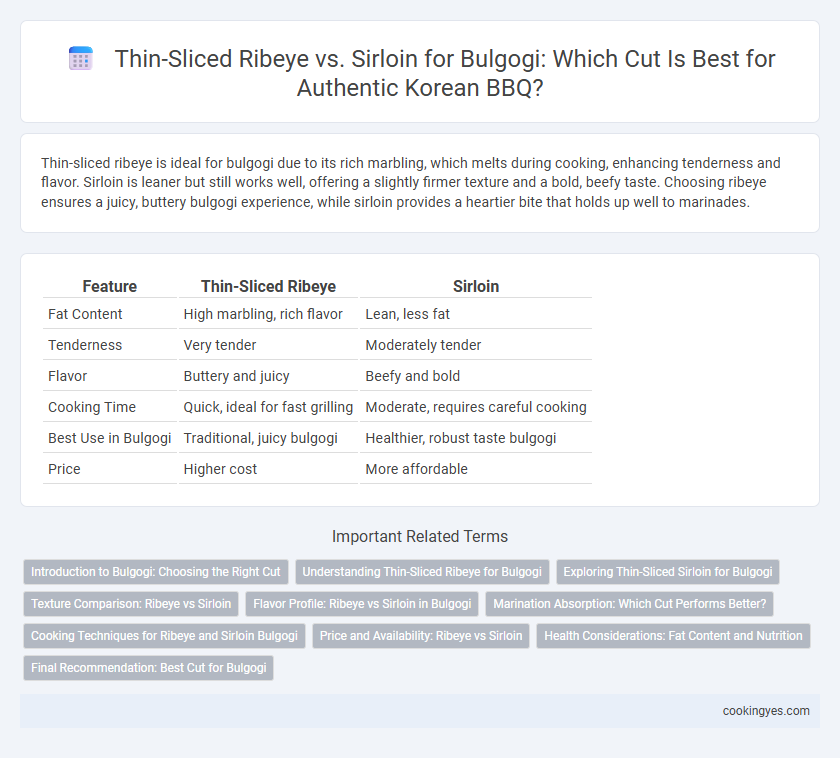Thin-sliced ribeye is ideal for bulgogi due to its rich marbling, which melts during cooking, enhancing tenderness and flavor. Sirloin is leaner but still works well, offering a slightly firmer texture and a bold, beefy taste. Choosing ribeye ensures a juicy, buttery bulgogi experience, while sirloin provides a heartier bite that holds up well to marinades.
Table of Comparison
| Feature | Thin-Sliced Ribeye | Sirloin |
|---|---|---|
| Fat Content | High marbling, rich flavor | Lean, less fat |
| Tenderness | Very tender | Moderately tender |
| Flavor | Buttery and juicy | Beefy and bold |
| Cooking Time | Quick, ideal for fast grilling | Moderate, requires careful cooking |
| Best Use in Bulgogi | Traditional, juicy bulgogi | Healthier, robust taste bulgogi |
| Price | Higher cost | More affordable |
Introduction to Bulgogi: Choosing the Right Cut
Thin-sliced ribeye offers rich marbling and tenderness, making it ideal for authentic, juicy bulgogi with a melt-in-the-mouth texture. Sirloin, leaner with a firmer bite, provides a slightly heartier flavor and holds up well to the marinade's robust seasonings. Selecting the right cut depends on preference for either a tender, fatty experience or a leaner, chewier bite in traditional Korean bulgogi preparation.
Understanding Thin-Sliced Ribeye for Bulgogi
Thin-sliced ribeye is the preferred cut for bulgogi due to its marbling and tender texture, which enhance the dish's rich and juicy flavor. The intricate fat distribution in ribeye melts quickly during cooking, creating a succulent bite that balances the sweet and savory marinade. Compared to sirloin, ribeye's natural tenderness reduces the need for extended marination, preserving the meat's delicate qualities in traditional Korean bulgogi recipes.
Exploring Thin-Sliced Sirloin for Bulgogi
Thin-sliced sirloin offers a leaner alternative to ribeye for bulgogi, providing a tender texture with less marbling but still absorbing marinades effectively. Its lower fat content results in a cleaner, beef-forward flavor that complements the sweet and savory elements of traditional bulgogi sauces. Utilizing thin-sliced sirloin enhances the dish's balance, appealing to those seeking a healthier yet flavorful Korean BBQ experience.
Texture Comparison: Ribeye vs Sirloin
Thin-sliced ribeye offers a tender, marbled texture that melts in the mouth, making it ideal for rich and juicy bulgogi. Sirloin presents a firmer, leaner texture, providing a slightly chewier bite that holds up well during grilling. Choosing ribeye enhances succulence, while sirloin delivers a satisfying, meatier chew in bulgogi preparations.
Flavor Profile: Ribeye vs Sirloin in Bulgogi
Thin-sliced ribeye offers a rich, marbled texture that delivers a tender and juicy bulgogi with deep, beefy flavors. Sirloin, while leaner, provides a slightly firmer bite and a cleaner, more straightforward beef taste that absorbs marinades well. Choosing ribeye enhances the savory sweetness and mouthfeel of bulgogi, whereas sirloin highlights leaner, more balanced flavor notes.
Marination Absorption: Which Cut Performs Better?
Thin-sliced ribeye absorbs bulgogi marinade more effectively due to its higher fat content and marbling, which allows the flavors to penetrate deeper into the meat. Sirloin, while leaner, tends to absorb marinade more superficially, resulting in a less intense flavor profile. For optimal marination absorption and richer taste, ribeye is generally preferred in bulgogi preparation.
Cooking Techniques for Ribeye and Sirloin Bulgogi
Thin-sliced ribeye offers rich marbling that melts during quick high-heat cooking, making it ideal for grilling or pan-frying bulgogi to achieve a tender, juicy texture. Sirloin, with its leaner profile, requires careful marination and slightly lower heat to prevent toughness while preserving flavor, often benefiting from a brief rest after cooking to enhance tenderness. Precision in temperature and cooking time ensures ribeye maintains succulence, while sirloin develops a more robust, savory profile without becoming dry.
Price and Availability: Ribeye vs Sirloin
Thin-sliced ribeye for bulgogi typically commands a higher price due to its rich marbling and tenderness, making it a premium choice often found in specialty butcher shops or Asian markets. Sirloin, while leaner and less marbled, offers a more budget-friendly option with wider availability in supermarkets and local grocery stores. Availability of ribeye can be limited depending on the region, whereas sirloin remains a versatile cut that is easier to source year-round for bulgogi preparation.
Health Considerations: Fat Content and Nutrition
Thin-sliced ribeye for bulgogi contains higher fat content compared to sirloin, contributing to a richer flavor but increased calories and saturated fats. Sirloin offers a leaner option with lower fat and calorie levels while providing high protein and essential nutrients like iron and zinc. Choosing sirloin supports healthier eating habits by reducing fat intake without sacrificing the nutritional benefits of bulgogi.
Final Recommendation: Best Cut for Bulgogi
Thin-sliced ribeye is the best cut for bulgogi due to its rich marbling and tender texture, which ensures a juicy and flavorful result when marinated and grilled. Sirloin offers a leaner option with slightly less fat, providing a firmer bite but less succulence. For authentic, melt-in-your-mouth bulgogi, ribeye remains the top choice, balancing tenderness and taste for an optimal dining experience.
Thin-sliced ribeye vs sirloin for bulgogi Infographic

 cookingyes.com
cookingyes.com